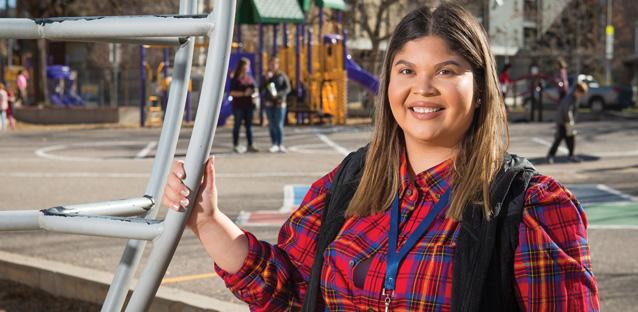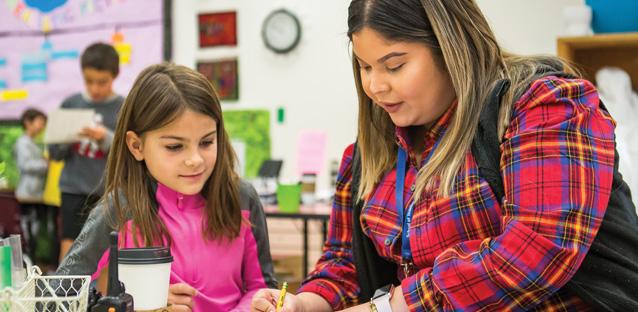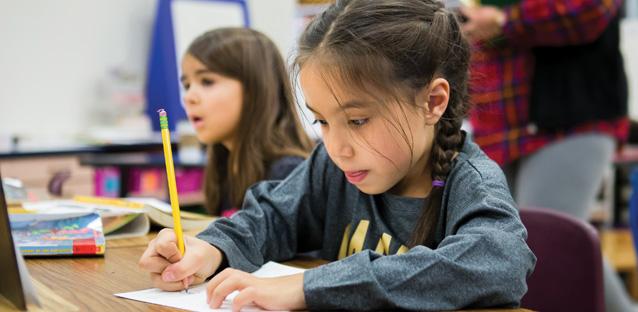UNC’s Center for Urban Education builds bridges with urban schools.
By Jaclyn Zubrzycki, Photography by Woody Myers
It was 1 p.m. on a Friday in October at the University of Northern Colorado’s extended campus in Denver’s Lowry neighborhood, and 24 students at the school’s Center for Urban Education, or CUE, were making a transition that had by now become routine.
By morning, they were paraprofessionals: unlicensed teaching aides and classroom assistants working in Denver metro area schools.
By afternoon, they were undergraduate students, studying methods for teaching elementary school science, culturally responsive ways of working with students from different backgrounds, and more.
The students, many of them still wearing their schools’ ID badges around their necks, were chatting in English and Spanish when Professor Frank Davila asked for their attention and laid out the plan for that afternoon’s session of The Education of Mexican American Students. First, an outside speaker would present on current immigration issues. Then, the students would share lesson plans they had developed.
Davila also gave an update on a recent writing assignment: “I like how what you’ve written includes what you’re learning from your students,” he told the class.
This deep connection between the UNC students’ education coursework, the school classrooms where they work, and the broader community contexts of urban schools is at the core of CUE’s unique approach to teacher preparation.
At a time when teacher workforce diversity and teacher turnover in urban schools are concerns, CUE is filling a gap by offering a hands-on, immersive program for a diverse group of aspiring teachers.
CUE’s students — nearly two-thirds of whom are people of color, and 90 percent of whom are first-generation college students — will have spent more than 3,000 hours in the classroom by the time they graduate. The state’s requirement for an education degree is just 800 hours.
That time spent in schools makes a difference: CUE graduates leave the program well-grounded in the stresses and joys of working in urban schools. And in recent years, 100 percent of them have been hired on as teachers by the time they graduate.
In the 2017-18 school year, 50 CUE students work in Denver Public Schools, 15 in Aurora Public Schools, 20 in Cherry Creek, 15 in private schools, and the rest in other local districts, including Adams 12 and Littleton.
History
Established in 2000 under the leadership of Irv Moskowitz, a former Denver Public Schools superintendent, CUE prepares teachers for the task of teaching in urban schools, which often serve students with diverse and complex backgrounds and needs.
The Center’s current director, Rosanne Fulton, is a UNC alumna with decades of experience in urban school districts.
“The vision is to give people the working experience within the school and the opportunity to become teachers,” she says. “It’s a beautiful thing.”
The Center currently enrolls 135 students focused on earning degrees in elementary education, special education, or early childhood education. Most earn a Culturally and Linguistically Diverse endorsement, which highlights their specific training in helping people transition to speaking English. The students also take liberal arts core classes through UNC’s main campus in Greeley.
Aurora Principal Brian Duwe, one of the partner principals, said that high rates of teacher turnover in urban schools point to the need for programs like UNC’s. In some Colorado districts, more than one in five teachers leave each year; in some schools, turnover rates are over 40 percent.
“I think about the sustainability,” Duwe says. “By building that pipeline from within, starting as a para, progressing to student teaching and teaching, teachers will be more prepared and less overwhelmed. It sets them up for more success.”
Diverse Learners
The diversity of the teaching force has been top of mind for many. Research indicates that if you’re a student, having even one teacher who shares your race or ethnicity can help improve your academic outcomes. Yet in Denver Public Schools in 2017, for instance, about three-quarters of students were students of color, while 73 percent of teachers were white.
Denver is not alone: About 80 percent of public school teachers nationwide are white, while a majority of public school students are not.
Paraprofessionals, on the other hand, are more diverse. In 2016, 65 percent of DPS paraprofessionals were educators of color, the district’s director of new teacher pathways and development told the education news site Chalkbeat.
That’s why, in addition to teaching them about culturally responsive teaching practices, CUE focuses on supporting its majority-minority student body.
“Any number of our students didn’t think they had the money or academic background to be successful in college,” Fulton says. “We provide them support academically and work closely with resources at the larger campus in Greeley.”
CUE also provides a career step for those who were already working as paras. While paraprofessionals perform an important role in classrooms, a search on the job site Indeed.com found that many in Colorado make less than $13 an hour.
“For us to help students move from a paraprofessional to teacher earnings is huge,” says Fulton.
Diversifying the Teaching Profession
Many CUE students come to the program having already worked in schools. One current student, for instance, was working in a school kitchen when she decided she wanted to teach.
In fact, just 27 percent of the school’s students come right out of high school. The rest have some work or other education experience before they come to CUE.
That was true for Weston Bernal, a graduate who is now in his second year teaching second grade at Isabella Bird Community School in Denver.
Bernal had started but not completed an undergraduate degree more than 10 years ago. He spent much of his 20s working at Starbucks. As he progressed in his role there, he found that he loved training others. That got him thinking about finishing his education and becoming a teacher.
He now recommends the program to others. “The fact that it’s here in Denver, working with this population — you get to work in classrooms … more than what you would in another teacher prep program,” he said.
And, with scholarships or grants, he said, “it’s really doable” financially. That makes a difference in an era where the cost of higher education is increasing.
When Bernal thinks of the future, his concerns about his career path aren’t about the stress of working in an urban school. He feels prepared for that. He’s more concerned about the financial feasibility of teaching in a state where teachers’ salaries have been ranked the least competitive in the nation.
“But what’s so nice about the UNC program is that when I stepped into my role as a first-year teacher, I didn’t feel like a first-year teacher,” Bernal said. “I felt like someone who had a year or two under my belt.”
Another highlight for Bernal: The program’s diversity and its focus on preparing teachers to work with diverse students.
“Growing up in Greeley, there’s a difference in the classrooms [in Denver] from a diversity perspective,” he said. “In elementary school, I was one of a few Hispanic kids with a bunch of white kids. I wasn’t necessarily able to identify with the people around me. Being in Denver, living in Denver, having a diverse community of people — what I’ve seen is, with diversity, you need specialized training, you need to understand culturally where people are coming from.”
A Reality Check
In Davila’s class in October, Jennifer Ruiz, a current CUE student, echoed Bernal’s comments.
Ruiz is an immigrant from El Salvador with temporary protected status who moved to the U.S. as a four-year-old. She is minoring in English as a Second Language.
“To me that was so important because of my personal experience,” she says. “I knew Spanish but had to learn English, and a lot of the ways they worked with me were awful.”
She says as a young person, she was pulled out of the classroom regularly. When she finally learned English, she says, she was placed in her school’s gifted and talented program. But before then, she says, “I felt they thought my language was a deficit rather than an asset. I knew what was going on, but I couldn’t communicate.”
At CUE, she says, “it’s a very hands-on experience. You get to speak up, you get to be listened to, and you’re accepted. It’s diverse: Michele’s from Peru, I’m from El Salvador, Nicole’s from New Jersey.”
Ruiz works with gifted and talented students at the Polaris at Ebert Elementary School in Denver.
She says working half days as a paraprofessional before coming to class made for long days, but the model of working while studying is helpful. “It’s a reality check. In all of my classes, they’re teaching me content but also how to deal with specific situations that I go through in the day.” UNC




